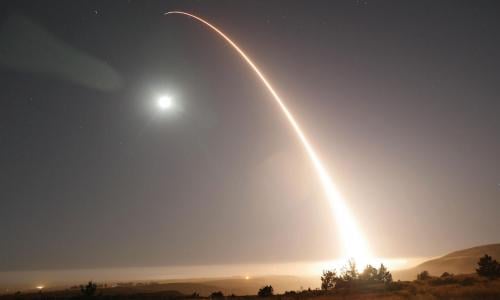Nuclear Weapons
Nuclear Weapons Solutions
Progress on US nuclear weapons policy may be slow and incremental—but it’s possible.
Roughly 9,000 nuclear weapons are hidden away in bunkers and missile siloes, stored in warehouses, at airfields and naval bases, and carried by dozens of submarines across the world.
A single warhead can demolish a city center. A full-fledged nuclear war would threaten life as we know it.
2,400
US nuclear weapons slated for dismantlement
But the risk of nuclear war isn’t fixed; with the right policies and safeguards, we can help protect against mistakes, accidents, and poor decision-making—and we can work toward a world free from the nuclear threat.
No-first-use
Nuclear weapons are meant to deter nuclear attacks from other countries. However, current policy allows the United States to begin a nuclear war by being the first to use nuclear weapons in a conflict—in response to a non-nuclear attack by North Korea, Russia, or China. A "no-first-use” policy would take this option off the table. The United States could pledge that it will never be the first to use a nuclear weapon, regardless of the circumstances. Doing so would reduce the risk of miscalculation during a crisis, and limit the possibility of a smaller, non-nuclear conflict escalating into a nuclear one. Without no-first-use, the US public is at risk of a devastating retaliatory attack, should the United States ever cross the threshold and start a nuclear war.
Sole authority
In the United States, the president is singlehandedly responsible for the decision to launch a nuclear weapon. They are not required to consult with anyone, and no one carries the authority to stop a legal launch order once given.
This system of control (known as “sole authority”) isn’t the only way to handle launch decisions. Other officials could securely be included in the decision, providing checks and balances and a basic defense against mistakes, accidents, miscalculations, and recklessness.
De-alerting
Currently, 400 nuclear-tipped missiles in the US heartland are kept on “hair-trigger alert.” If sensors show an incoming nuclear attack that threatens these missiles, it’s US policy to alert the president, who would need to order their almost immediate launch to prevent them from being destroyed—before the attack is confirmed as real.
But sensors can be wrong. A long list of nuclear close calls—which include technical malfunctions, miscommunications, and plain bad luck—shows how close we’ve come to mistakenly starting nuclear war.
Taking these missiles off hair-trigger alert (or “de-alerting”) would immediately remove the risk of a mistaken or accidental launch, while preserving our ability to retaliate with missiles on submarines hidden at sea.
Smarter spending
The United States is currently planning to spend an estimated $1.7 trillion dollars over the next three decades to maintain and replace its entire nuclear arsenal with new weapons, including nuclear-armed bombers, missiles, and submarines.
Such a tremendous investment of money and effort is unnecessary. It also encourages Russia to build more capable weapons of its own, accelerating an emerging and destabilizing international arms race.
Instead, the United States should eliminate some types of nuclear weapons, refurbish the remaining weapons where possible, and make any necessary replacements without enhancing capabilities.
International agreements
A total of nine countries possess nuclear weapons. Reducing the risk of nuclear war will require domestic policy changes within all those countries, as well as cooperation and verified agreements between them.
Diplomacy has a strong track record. Multiple treaties and agreements—and decades of dialogue and cooperation—helped reduce US and Soviet arsenals from a high of 64,000 warheads in the 1980s to a total of around 8,000 today.
The United States should build on those successes by extending the New START Treaty with Russia; committing to a “diplomacy first” approach with North Korea; and rejoining the Iran Deal, which limits Iran’s capacity to produce weapons-grade uranium.





Comments
Post a Comment